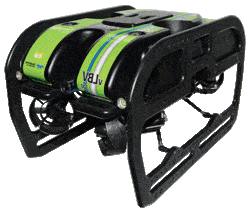Military ROV Systems & Technology

vLBV300-ISO Remotely Operated Vehicle by Teledyne Marine
ROVs (remotely operated vehicles) are a form of UUV (unmanned underwater vehicle) that are remotely controlled by a human operator and do not have autonomous capabilities. They can be operated either from the shore or from a naval vessel, and use an umbilical tether that consists of an armored coated encasing, electrical and optical cables for power, communications and data. This tether is required due to the fact that radio waves do not travel well through water and thus would be impractical for communicating with the ROV.
Military ROV Launch & Propulsion
Small military ROVs may be man-portable and easily launched and recovered by hand. Larger vehicles may be launched through the moonpool of a support vessel, or may require a LARS (launch and recovery system) to be installed on board, consisting of a crane and winch mechanism.
ROVs maneuver using underwater thrusters, which use an electric or hydraulic motor connected to a propeller in order to create thrust. Smaller ROVs typically utilize electric thrusters, whereas hydraulic propulsion is usually limited to larger vehicles due to the extra space and carrying capacity required.
ROVs may be used for a wide variety of military, law enforcement and security applications. Deployment of military ROVs often reduces the need for human divers to be sent into the water, thus reducing the risk to personnel.
Military ROV Applications & Payloads
Military ROVs are often used for mine clearing and EOD (explosive ordnance disposal). They may be equipped with manipulator arms and mine cable cutters as well as charges that can be triggered acoustically from shore to detonate explosives.
ROVs may also be used by the coast guard or naval forces to undertake port security and vessel inspection. They may use high-definition cameras, floodlights or sonar to check the hulls of vessels for contraband, attached explosives and other threats, as well as to assess damage and check if repairs or maintenance are required.
















